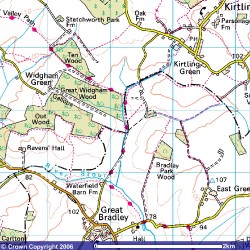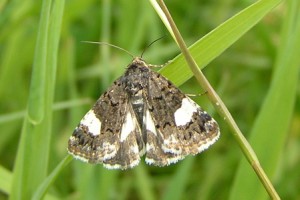New Sites for Four-Spotted Moth in Cambs, Essex & Suffolk
Authored by Sharon Hearle, Regional Officer, East Anglia October 2005
The Four-spotted (Tyta luctuosa) seems to have had a good year in 2005 with a number of new locations for the moth located in Cambridgeshire, Essex and Suffolk through targeted survey by Regional Officer Sharon Hearle and many volunteers. The Four-spotted moth is a high priority UK Biodiversity Action Plan Species and information about its distribution is needed to help plan conservation work.The Four-spotted moth flies on sunny days and is very distinctive, a mainly black moth with four large white spots. As it is diurnal, it is a great one for butterfly recorders to search for. The moth is single or double brooded and can be seen from mid May to mid August. Four-spotted larvae feed on Field Bindweed growing in hot, dry open sites with sparse vegetation including grassland on chalky soils, field margins, embankments and derelict ground.
The Regional Officer has benefited from detailed work on Four-spotted moth by Paul Waring, including a visit to a well known Peterborough site that has been monitored by a transect walk for several years. The Peterborough ditch bank habitat at Werrington appears very similar to the new sites located in Cambridgeshire and Suffolk.
Four-spotted moth was recorded this year at Great Wilbraham near Cambridge (click here for aerial photo) along the edge of a railway cutting and in an area of adjacent set-aside. This was not far from where the moth has been recorded in previous years by John Dawson and had thus been identified as a potential site. Visits in 2004 were negative but this year Four- spotted was recorded on several occasions with a maximum count of 5 on 8th June. The set aside field was a sea of Ox-eye Daisy in June, one of the favoured nectar sources, and the moth was also observed moving through open grassland at a low level.
One Four-spotted moth was recorded near Great Bradley in Suffolk on 16th June 2005. This follows a record of one to MV light just over the border in Cambridgeshire at Kirtling in July 2004, about a mile away.
| The Kirtling Channel | |
Kirtling and Great Bradley are linked by the Kirtling Channel. |
|
| © Reproduced by kind permission of Ordnance Survey on behalf of the Controller
of Her Majesty's Stationery Office © Crown Copyright. All rights reserved. Licence number AL100015237 |
One side of the banks is cut in the autumn and the uncut bank is now quite scrubbed over in places. This site provides ideal habitat for the Four-spotted moth.
It is also possible to see good numbers of Small Heath, Brown Argus and Common Blue butterflies and many other day flying moths. There is a public footpath along the edge of this channel from Kirtling to Great Bradley.
The Four-spotted has not been recorded in Suffolk since 1995. It used to be regarded as frequent in the Breck district of Suffolk but has not been seen for decades despite searching. It is a moth that does come to light and is not likely to have been overlooked in the Brecks where many moth traps are operated.
It has also been recorded at several locations in north east Essex around Great Chesterford, Ickleton and Littlebury including one occasion where over 100 individuals were seen.
| Four-spotted | |
|
It is now quite possible that Four-spotted could be found at more sites in the
area between Saffron Walden, Cambridge, Haverhill and Newmarket, especially where artificial
landscape features such as banks and railway cuttings occur in the arable landscape. |
| © Sharon Hearle |
The next challenge will be to work with framers and land owners to identify conservation measures that will help secure the future of the Four-spotted moth in the long term.

